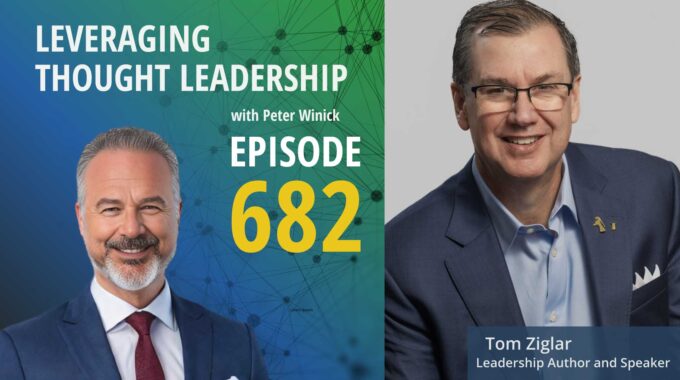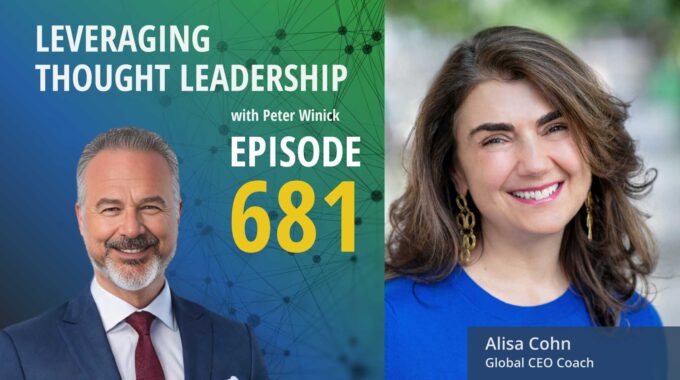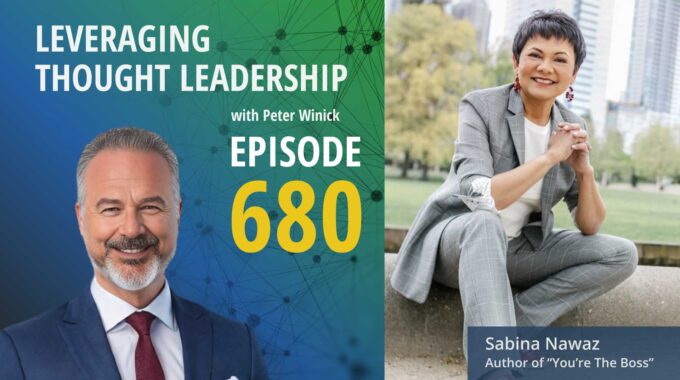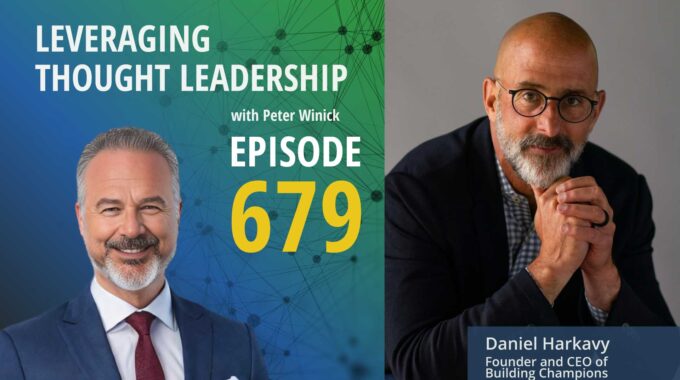How AI, Programs, and Trust Turn Ideas into a Life-Changing Business This episode explores how…
Organizational Thought Leadership Practices | Carmen Fontana | 214
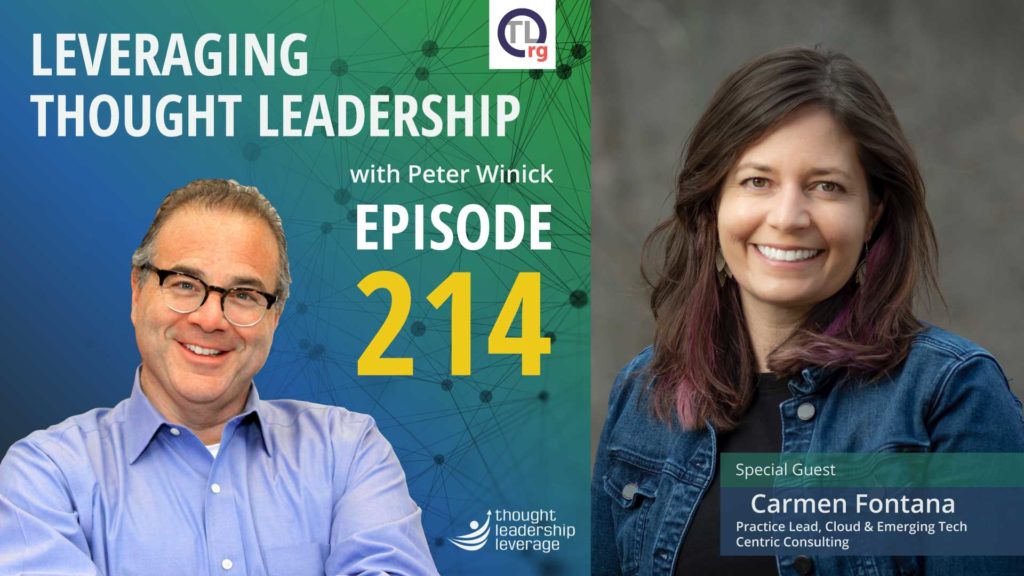
Defining the Term Organizational Thought Leadership
An interview with Carmen Fontana about organizational thought leadership practices, and the meaning of the term “organizational thought leader.”
We interviewed Carmen Fontana, Modern Software Delivery Service Offering Lead at Centric Consulting. She’s responsible for strategy, business development, and client relationships within our Modern Software Delivery service offering, and she’s here to talk to us about what it means to be an organizational thought leader.
Three Key Takeaways from the Interview:
- What it means to be an organizational thought leader.
- Why sharing your successes in organizational thought leadership keeps people coming back to learn more!
- How building a company’s brand can lead to developing content and thought leadership strategy.
Join the Organizational Thought Leadership Newsletter to learn more about expanding thought leadership within your organization! This monthly newsletter is full of practical information, advice, and ideas to help you reach your organization’s thought leadership goals.
And if you need help scaling organizational thought leadership, contact Thought Leadership Leverage!
Transcript:
Peter Welcome, welcome, welcome. This is Peter Winick. I’m the founder and CEO of Thought Leadership Leverage and you’re joining us on the podcast today, which is Leveraging Thought Leadership. Today, my guest is Carmen Fontana. Carmen leads Centric Consulting’s modern software delivery practice focusing on Cloudland emerging tech with more than 20 years of experience. Present is where innovation needs data driven decision making. Say that three times fast. So this is this is part of them. We just try to get everybody calibrated. That’s listening today. We’re doing a new series on what we’re calling organizational thought. So these are folks that are using thought leadership as part of their part of the job. Part of what they do in the in the organizational slash corporate world. So the themes and the conversations we’ll have might sound a little bit differently on this thread. So we’ll just dove in with their. So why don’t we start with sort of your role and how the thought leadership part of your role continues to grow and evolve given what you do.
Carmen Fontana Yes. So Centric is a business and technology that’s holding firm. And I co-lead one of our practices, the modern software delivery. And so, every day is a little bit different for me. I oversee the delivery. So the folks on my team that are providing cloud and emerging tech services to our clients, the operation. So just the mechanics of running a line of business and then business development. And so business development is, you know, a lot of the work that we get is from people we know relationship selling. But a bigger and bigger piece over time is trying to influence buyers that maybe aren’t in our Rolodex. And so that’s where the thought leadership piece comes in.
Peter Got it. So. At Centric, so. Thought leadership sits under biz-dev, so somewhere in that marketing biz dev sales planet, right. So what are the lodestones? Let’s start with some of the basics. So how are you and the organization defining thought leadership? Because I think there’s some struggles with what is content marketing versus what is thought leadership versus what is just not anything.
Carmen Fontana Yeah, it definitely is a gray area. And I’ll be the first one to say, you know, we don’t have a hard and fast rule about it. You know, in professional services, it is a little bit different. We’re not selling widgets. Nobody finds a blog on our website. He’s read the 300-word blog article and buys our services. It’s just not how professional services are sold. And so, you know, really, you know, for us what leadership is all about cultivating and credentializing ourselves. So starting that conversation with potential leads, knowing that it’s going to take many conversations before they get to the buy and along the way credentializing ourselves and our professional services. Only thing we have to sell is ourselves and our skills. We have as consultants. And so, we need to demonstrate our expertise and thought leadership is the natural vehicle for that.
Peter So it was a couple of thoughts. There one is on the long tail of the sales cycle. We go sort of that pre lead phase, right. One of the benefits of thought leadership is before someone’s even potentially in the market, they can be consuming your content and being influenced by what you have to say and have some level of connection to you so that at such point, maybe it’s a year down the road, two years down the road, whatever they may be in the market, they may be in a meeting where somebody talking about a solution that you can provide. Then they can sort of float the idea as a watchman following, you know, so-and-so at such and such an organization. And they’ve got some cool stuff. Is that does it line up to what you’re doing?
Carmen Fontana Yeah, absolutely. You know, a lot of our buyers are CIO chief information officers, and they’ve got so many things on their plate. They’re tracking so many different technology pieces. And so being able to get, you know, even a sliver of their head space and continuing to tell the stories around a certain technology. It allows it to be kind of planted in their heads. So when the time is right and their organization, which might be twelve or 18 or 24 months down the line and they need X Y, these services, my name or Centric’s name is going to come to their head.
Peter Got it. Got it. And how do you deal with the inherent struggles slash conflict of pitching product inside of the content versus not because effective thought leadership never mentions. Oh, by the way, buy from us. Right. Right. But traditional market. What? What’s the call to action? And there’s that that friction, because it does go against some of the traditional marketing has told us, although we obviously fresh is a bit different.
Carmen Fontana Yeah, exactly. You know, it is. What is the call to action? And a lot of times it’s a little bit more nuanced. That’s not a by now click the button. It’s more like, hey, you like this short blog article? Do you want to download our white paper on this or attend our webinar? That’s coming up. And so those are a call to action. It’s more, hey, to how do we keep the conversation going and creating action points that keep that conversation moving.
Peter Got it. And in your organization, because, you know, most organizations are fairly new to the game with thought leadership, right? People are. It’s anything from a buzz word to actually a well-defined activity that’s connected to KPI and all that stuff in your organization. How do you go about celebrating any of the wins? Right. So like you said, nobody’s going to read a blog post, then click a button and say, great, here’s my American Express for 1.3 million dollars buy. That probably doesn’t happen.
Carmen Fontana But I wish it did. Trust me, I wish it did.
Peter That that would be nice. Right. But so, how do you make sure that you’re so self-promoting but not really supporting, making those bringing awareness to those? They need to know that. Yes. Along the way in sales, here’s to places where we help you. Here’s someone saw speak speaker. How do you go about doing that?
Carmen Fontana Yeah. You know, so I think it’s where you need to bury the type of content. And so we do a lot of thought pieces. Ah, you know, here’s our stance on X Y the OR here’s how ABC work. But we pepper that also with client testimonials, client stories. They’re not blatantly selling it more like Acme Corp. had this challenge around the migration. Centric came and these are the things we did to overcome that challenge. And here are the outcomes. So it is not kind of to their own horn. And we really try to place it as the story of our client versus the story of Centric. Yes, there is a nuance, but yeah, Centric was the one helping that client be successful.
Peter Got it. What’s your take on what’s your philosophy on modalities and experimenting with Centric? Because, you know, a lot of people erroneously equate thought leadership with, oh, okay, we’ll write a white paper. Not that there’s anything wrong with white papers. They just tend to be somewhat dull and dry and, you know, not. The most interesting thing to read for most people. So. What’s your take on various modalities?
Carmen Fontana Yeah. You know, we do all you know, all the standard things, the blogging, the webinars, the white papers. But I also like to experiment particularly on LinkedIn and try to do some of the things that I see being done in the consumer space and try those on the B2B space. And, you know, for instance, I do videos where to promote a webinar or an offering we have. And those do really well. And they’re very they’re not professionally produced. They’re just me and my iPhone walking around my neighborhood talking about something. And I think they do well, because I think sometimes in the B2B space, we think we have to be very stuffy and formal and all of our marketing communications. And I thought leadership. But I tend to think, you know, our buyers, even though they’re at work, they’re still the same person they are when they’re consumer. And those messages and those formats that they respond to as a consumer that doesn’t go away when they step in front of their work laptop. Those things are still there.
Peter Yeah. And I would say in the B2B space. We have this expectation where everything is so perfect and everything is so powerful. And there’s a time and place, right? I’m not saying that you should have typos and proposed, right. Or, you know, clipart on your website or something like that. But at the end of the day, you know, it’s people dealing with people. And if you’re having a conversation about a webinar that you’re hosting or something next week, I think it’s totally cool that it’s not this very stiff in studio, you know, overly produced green screen thing that looks like an infomercial. But, hey, you know, you’re walking the dog, you your iPhone out and you’re just thrown up 90 seconds of him really excited talking about next Wednesday. And I think people have to sort of recalibrate their expectations. I don’t think you want to go full Gary V dropping the F bomb. Yes. But what is that level of casual for you and your business? Right. Which is different in every business.
Carmen Fontana Yeah. And I think it’s especially important in professional services. But while we credentialize ourselves and there’s a time and place to be very formal and academic at then the day they are buying people services and the people that they’re engaging with on these marketing platforms and people they’re going to be engaging with on the project. And nobody wants to work with people that are boring and stodgy on their projects. You know, for six or twelve months, they want somebody. You know, I think I think I can hang out with Carmen, and I think I’d like to do that project with Carmen. And so that’s why some informal channels are really important as well. So they get a sense of my personality and the personality of Centric.
Peter Very cool. What? What else would you say or examples of? Well, actually, do it this way. An example or two of a couple of specific pieces that you put out that maybe surprised you that it resonated so much. Because the other thing is we’re awful at predicting what’s going to work well, just in general when it comes to putting thought leadership out of the B2B world, which is why I believe you have to have some of this experimental mindset. Could you give an example or two to me? You’re like, well, I’m totally shocked that people were jamming up on that.
Carmen Fontana Yeah. So I gave you one example, you know, I do, I call them the walk and talk videos on Linked-In where just me and the camera. Those do really well, very informal. And then maybe on the other extreme where we’ve seen a lot of successes is when we do very deep, very technical, multi-part series on a very niche, technical subject where we find the least amount of traction is kind of the listicle. You know, here’s five tips for blahblahblah. Those don’t resonate, I think, because they’ve been done and our market is pretty savvy. The CIO market, they’ve seen, been there. They’re they want to think the things.
Peter That sort of click baity stuff. It could be that you market is just too smart for that. There’s some.
Carmen Fontana Yeah, they say that they know it already. Exactly. And so that they will read a five part people technical series with words that nobody understands before they’ll read a listicle.
Peter But the reason they’re investing their time in that is they’re getting value from it. Right. So it’s not about tangible value. It’s again, you know, if you go back to sort of defining thought leadership, it’s showing that the you know, you’re in the consulting business, you’re selling brains. Right. So it’s a vision of how to Centric think. Who are the types of people that we work with and how do we wrap your head around the problem? Look, we took something really complex and chunked it out into easily digestible ways. That is ultimately a great way to showcase the capabilities of consulting.
Carmen Fontana So absolutely, it demonstrates the breadth and depth of our expertise, and that is what our audience is looking for.
Peter So do you see additional investments being made in a variety of thought leadership activities and more people in the firm being asked to partake in some way, shape or form?
Carmen Fontana Yeah. This has been a kind of a new area for Centric over the last year, we’ve had a couple of people, myself included, experimenting with building out our personal brand to developing our content and thought leadership strategy. And our initial foray has been very successful. And as a result, as we look at the 2020, we are expanding it to more people as well as people in different types of roles, people that are very technical people and more BD roles and really helping develop our personas across the firm.
Peter Got it. Got it. And what do you think that might be coming at the expense of meaning? You know, as marketers, because ultimately you have to justify the investments being made to say, OK, it got us an outcome that we wanted. Right. We stood out from the competition. The clients are mentioning it. Potential clients are mentioning it. What do you think might be at risk in terms of marketing activities that B2B firms, consulting firms, special services, etc. are doing that aren’t getting the yields they used to?
Carmen Fontana Yeah. You know, when you invest in thought leadership. My quick answer is you investment in thought leadership and you lose sleep. I don’t really. But, you know, in our type of firm, we are in a billable capacity. And so, time is money, right. And so, it is a tradeoff. So hours that I’m not billing directly to a client. They need to have a great hour, a lie. And so that’s where it’s important to be thoughtful in thought leadership and making sure the activities I’m doing exceed the R.O. I would have if I was billing it those hours to a client. And so that’s the tradeoff that you can do thought leadership all day. But then you’re not delivering to your client and getting any real time ROI. And if you do that all the time on billable, you’re not building out your pipeline of a business settlement either.
Peter So the constraints you just put on that is saying, listen, you know, the firm knows. I mean, it’s actually quite easy in a consulting firm to say, OK, my day rate is my hourly rate is whatever. Right. And then they can figure out the multiple and figure out the margin contribution. So I love holding it to that standard. Right. So I’m going to transfer to this activity of thought leadership. It has to yield at least the same or like maybe even greater to justify doing it. And that’s an interesting play. I want to talk about setting expectations and timeframe, because everybody’s impatient. Right. Every sales manager is worried about this quarter. Every sales person is worried about this week. Put thought leadership is not a get rich quick. It’s not flying to a conference. Come back with a stack of 50 leads and then the rainbows and unicorns and magic happens. Talk about sort of realistic expectations around getting buy-in and timeframes to say those. Don’t judge me by this article being place. This is the time period I need.
Carmen Fontana Yeah, it is. It’s a long play if you’re in it for the short term, are going to be really disappointed. Now it’s a twelve to 18-month cycle arc. Our clients aren’t buying the stuff on a regular. So you have to hit them at the right time and it takes a while to get your name. You know, the repetition of your name and your services out there. So, you know, what’s really important for us is just to track the metrics, not necessarily how many wins, where it can be completely distributed to thought leadership, but how many views are each post having, how many clicks on the website, how many downloads of the webinar. You know, things of that nature. And if you see that growing over time and you can see that there’s momentum behind your thought leadership practice, it’s very difficult to tie an actual cell to a one singular thought leadership activity.
Peter So why is that?
Carmen Fontana Go ahead.
Peter This is so early on in the absence of any metrics. The basic metrics are engagement, shares, confidence, etc. etc. However, what do you do or has there been cases where you’ve got some content that people are engaged with this journey with whatever? It doesn’t really do anything other than create conversations and noise amongst themselves or you know that they’re not engaging with the firm. How do you deal with that? Or have you seen that?
Carmen Fontana Yeah. You know, one of the things we try to do is when we have meetings with clients, we. I asked some leading questions. Hey. Have you read any of our cloud articles on multi-cloud strategy? Or did you happen to attend our webinar and we take notes on what the buyer has?
Peter Sure.
Carmen Fontana In terms of engagement. We have metrics behind the scene, you know, through our CRM type system, but also that affably and take note of that and say, no, no, what content resonates, but also to see that the thought leadership has influenced the buying process.
Peter Got it. Got it. One of the other things I’ve seen is sort of conflicting content. Develop them in a business development so it doesn’t have to be Karmen, create stuff and then the stuff goes out. It’s sort of a linear fashion. Then you wait for reaction, but you can interview people. I mean, there’s other things that you can do to get folks into the mix of the creation of the thought leadership early on if dabbled in any of that.
Carmen Fontana Eh, eh, you’re alluding to like buyers or within an organization.
Peter Yeah. Yeah. Yeah. So either you’re in the organization or buyers or, you know. I guess from going as you don’t have to do this in isolation. And if you’re solving a problem that keeps CIOs up at night. Part of the way to express that thought leadership is to potentially interview them, survey them, etc..
Carmen Fontana Absolutely. And some of my colleagues are doing that exact thing. Our CEO is writing a book on remote work and a virtual company. And does one of the things he’s done is talk to different organizations that allow remote work and using that to influence the book that he’s written. And so definitely, you know, it’s great. We have such an interesting, diverse client base. And so, we’ve been able to use them with Industry Roundup sitting on panels, things that are.
Peter Great. Any final tips, tricks, you know, pitfalls that you’d put out there to get something to think about is there is there going down that thought leadership route?
Carmen Fontana I’d like to say I’d encourage people to give it a try for whatever reason, people are totally fine with social media and their personal lives. The more Instagram and Twitter all day long. But when I flip the switch on the career switch and they’re thinking about and B2B space, they are gearing headlights to get frozen. And it’s such a great business opportunity to engage in thought leadership. And so, I’d really just encourage people to give it a try. The bar’s low in the B2B space and I think the survey getting out there, we’ll get to a lot of exposure that few that weren’t planning on.
Peter Great. Well, thank you so much for your time. Continue. I’ll continue to monitor what you guys are doing, as I think you should of on the cutting edge for professional services and getting things out there and doing it consistently, which is important, too. Thanks so much for.
Carmen Fontana My pleasure. Thanks for having me.

